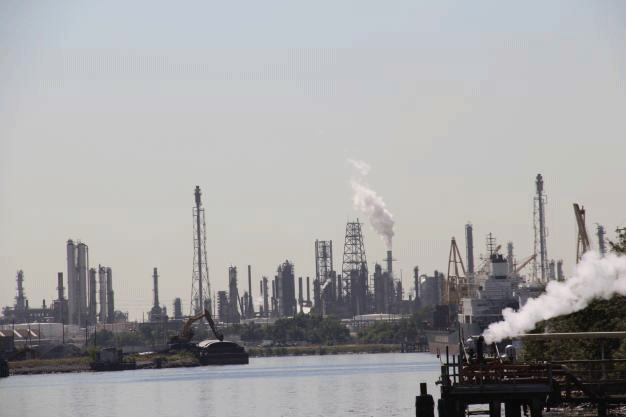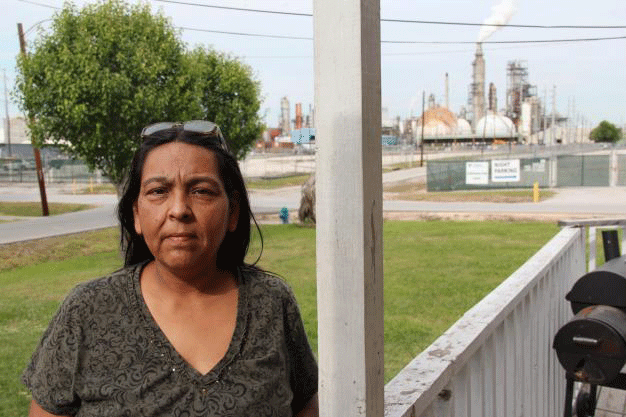Clearing the Air In Houston
Air Date: Week of May 2, 2014

Refineries and petrochemical plants line the Houston Ship channel, a 26-mile industrial canal. Houston has never met federal air quality standards for ozone. (Photo: Reid R. Frazier)
Houston, Texas, is home to the largest chemical hub in the Americas and is one of the smoggiest US cities. As the Allegheny Front’s Reid Frazier reports, the city is working to clean up its air but still has a long way to go.
Transcript
CURWOOD: One of the cities that’s often on the Lung Association's black list is Houston, Texas. And it's there again this year -- because of its elevated amounts of ground level ozone. Houston is home to the largest chemical hub in the Americas, and it's one of the smoggiest cities in the US - even though it's been working hard to clean up the air, and things have gotten better. Reid Frazier of the public radio program the Allegheny Front reports, Houston has had success mainly by focusing on its chemical plants.
[TRAINS IN MOTION]
FRAZIER: Railcars filled with chemicals rumble through Houston's east side. The city's industrial plants pump out about a quarter of the country's petrochemicals. And the plants have helped fuel the city's economy. But they also have added to its poor record of air quality. For years, Houston has had some of the highest levels of smog in the country.
But its air is getting cleaner. In a trailer parked on an industrial road near the outskirts of Houston, Steve Smith points to a rack of monitors.
SMITH: These are the particulate mass monitors.
FRAZIER: Smith is with the Houston Regional Monitoring network. It's an industry-funded group that monitors the air to help companies comply with federal air quality rules. He points to another machine – it’s a metal box with a digital read-out on the front.
SMITH: This is the ozone analyzer-and it's currently reading 29.6 parts per billion. OK. And that's - the instantaneous number - that's good.
FRAZIER: Smog is created when sunlight interacts with a mix of pollutants. One key ingredient in smog are volatile organic chemicals, or VOCs. Smog can burn the lungs and eyes, and exacerbate asthma and respiratory illness. With its steamy weather, millions of cars on the road, and hundreds of industrial plants releasing those VOCs, Houston is an ideal place to make ozone.
But over the past decade, the city has made big strides in curbing its ozone - a 20 percent drop according to state figures. The decline is tied to many factors, including new regulations. But, Smith says, the biggest factor of all is pretty simple: people are paying more attention to it. There are more than three dozen stations like this scattered around the city measuring pollution. And he says, they're making a difference.
SMITH: If you monitor, it will get better.
FRAZIER: It wasn't always like this. In 1999, Houston overtook Los Angeles as the city with the highest ozone levels in America.
HENDLER: Yes, we were the ozone capital, for a while.
FRAZIER: Elizabeth Hendler is a former state air quality planner who now works as an environmental consultant. The city's air quality became a story - and that was bad for business, she says.
HENDLER: For the local government and the civic community and state, that was just kind of a wake up call.
FRAZIER: Under federal pressure, Texas launched several air studies in Houston. Scientists from around the country came to study the air here. Harvey Jeffries was one of them. He's a retired chemistry professor at the University of North Carolina.
JEFFRIES: There were huge increases in ozone that lasted an hour, and vanished.
FRAZIER: Where were these increases coming from? Scientists flew over the city with infrared cameras that could pick up stray gasses. They found big leaks. The worst were from chemical plants, that made ethylene and propylene - the building blocks of plastic.
JEFFRIES: They were having thousand pound releases, 5,000 pound releases, 20,000 pound releases, in one case 200 thousand pound releases...of the most reactive compounds you can imagine.
FRAZIER: Jeffries says ethylene and propylene posed a problem in Houston, because they're highly reactive VOCs. That means they can make ozone very quickly.
JEFFRIES: ...and when that stuff gets emitted in the daytime, it cooks up the highest amount of ozone you've ever seen.
FRAZIER: Scientists also realized chemical plants were chronically under-reporting their emissions. A lot of this pollution was leaks in valves, and flanges, or tiny holes in pipelines.
Armed with new data, the state took action. It curbed emissions from sources like cars and the construction industry, but it also zeroed in on petrochemicals. Texas implemented a special cap-and-trade system just for chemical plants.
So what happened? Elizabeth Hendler.
HENDLER: Well, ozone came down a lot.
FRAZIER: Everyone agrees. This is good news for the air in Houston. But environmental groups say the air is still too dirty. Adrian Shelley is director of the environmental group Air Alliance Houston.
SHELLEY: Better does not mean good.
FRAZIER: Shelley points out that ozone levels in Houston still reaches unsafe levels 30 days a year. And since the EPA started regulating it in the 1980s, the city has NEVER met a single health-based standard for ozone. And on days when ozone is high….
SHELLEY: Asthma patients will tell you for example that there is no question for them about when ozone levels are high because they feel it immediately when they go outside.
FRAZIER: Shelley says air quality may actually get worse with many of the city's chemical plants planning expansions. At least, that's what he's afraid of. These plants are adding capacity to take advantage of gas from the fracking boom. Fracking has made ethane - a key component of natural gas - historically cheap.
So chemical companies are building like crazy along the Gulf coast to take advantage of this low cost raw material. In Houston, Shelley's group is fighting to have regulators impose stricter pollution controls on new facilities, so that these new plants don't actually make Houston's air any worse. Adding difficulty to the issue is the fact that Houston has no zoning laws. That means some residents live across the street from huge refineries and chemical plants.
[INSIDE HOME OF APOLLONIA MARTINEZ]

Apollonia Martinez on her front porch in Manchester, a Houston neighborhood, and a community next to the Houston Ship Channel. She said her son has asthma attacks from air pollution. (Photo: Reid R. Frazier))
Like Apollonia Martinez. She lives in Manchester, a low-income neighborhood between a rubber plant and a refinery. Standing on her porch, she says one of her sons has been having a lot of asthma attacks lately.
MARTINEZ: So every now and then I have to give him treatments because of his breathing problems at night.
FRAZIER: Martinez says she would like to leave Manchester, but can't afford rents in more expensive neighborhoods.
Business leaders admit that living next to a plant may not be ideal, but they point out that, except for ozone-the air in these neighborhoods generally meets federal health guidelines. Craig Beskid is executive director of the East Harris County Manufacturers' association - that's a local industry group.
He says Houston's chemical and refining sector contributes about 30,000 jobs to the local economy. And these are good paying jobs with salaries ranging from $40,000 to $200,000 a year.
BESKID: A great benefit in anyone's life is to have a good job. And when you live in a vibrant and growing economic area, good jobs are plentiful.
FRAZIER: And the plants provide these jobs while also releasing fewer and fewer emissions every year, he says. In fact, Houston might not even have the highest ozone in Texas anymore. That distinction might belong to Dallas Fort Worth. A big new source for emissions in that there? Fracking for natural gas.
CURWOOD: Reid Frazier reports for the public radio program the Allegheny Front.
Links
Living on Earth wants to hear from you!
Living on Earth
62 Calef Highway, Suite 212
Lee, NH 03861
Telephone: 617-287-4121
E-mail: comments@loe.org
Newsletter [Click here]
Donate to Living on Earth!
Living on Earth is an independent media program and relies entirely on contributions from listeners and institutions supporting public service. Please donate now to preserve an independent environmental voice.
NewsletterLiving on Earth offers a weekly delivery of the show's rundown to your mailbox. Sign up for our newsletter today!
 Sailors For The Sea: Be the change you want to sea.
Sailors For The Sea: Be the change you want to sea.
 The Grantham Foundation for the Protection of the Environment: Committed to protecting and improving the health of the global environment.
The Grantham Foundation for the Protection of the Environment: Committed to protecting and improving the health of the global environment.
 Contribute to Living on Earth and receive, as our gift to you, an archival print of one of Mark Seth Lender's extraordinary wildlife photographs. Follow the link to see Mark's current collection of photographs.
Contribute to Living on Earth and receive, as our gift to you, an archival print of one of Mark Seth Lender's extraordinary wildlife photographs. Follow the link to see Mark's current collection of photographs.
 Buy a signed copy of Mark Seth Lender's book Smeagull the Seagull & support Living on Earth
Buy a signed copy of Mark Seth Lender's book Smeagull the Seagull & support Living on Earth

